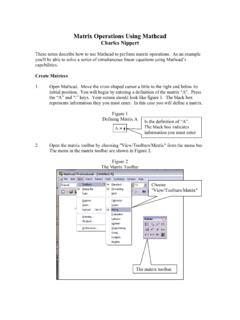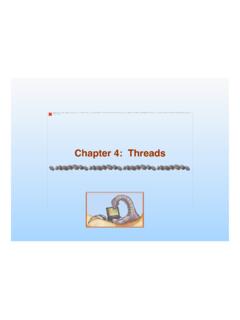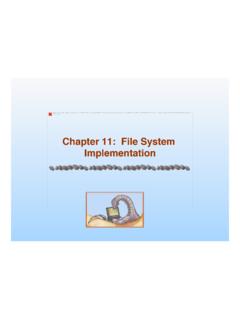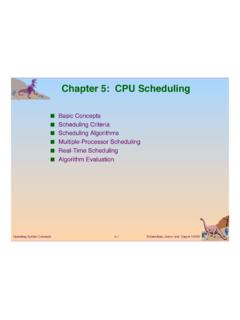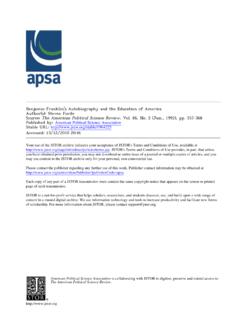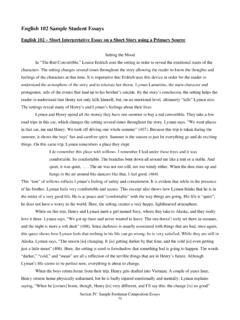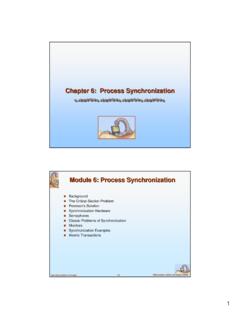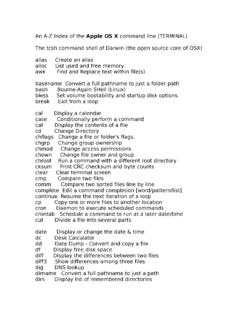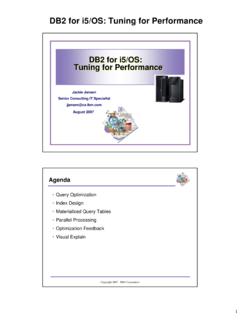Transcription of Chapter 7: Deadlocks - Louisiana Tech University
1 The image cannot be displayed. Your computer may not have enough memory to open the image, or the image may have been corrupted. Restart your computer, and then open the file again. If the red x still appears, you may have to delete the image and then insert it 7: Deadlocks ! !Silberschatz, Galvin and Gagne 2005! operating system Concepts! Chapter 7: Deadlocks ! The deadlock Problem" system Model" deadlock Characterization" Methods for Handling Deadlocks " deadlock Prevention" deadlock Avoidance" deadlock Detection " Recovery from deadlock " !Silberschatz, Galvin and Gagne 2005! operating system Concepts! Chapter Objectives! To develop a description of Deadlocks , which prevent sets of concurrent processes from completing their tasks" To present a number of different methods for preventing or avoiding Deadlocks in a computer system .
2 "" !Silberschatz, Galvin and Gagne 2005! operating system Concepts!The deadlock Problem! A set of blocked processes each holding a resource and waiting to acquire a resource held by another process in the set." Example " system has 2 tape drives." P0 and P1 each hold one tape drive and each needs another one." Example " semaphores A and B, initialized to 1" P0"" P1"wait (A);!!wait(B)!wait (B);!!wait(A)! !Silberschatz, Galvin and Gagne 2005! operating system Concepts!Bridge Crossing Example! Traffic only in one direction." Each section of a bridge can be viewed as a resource." If a deadlock occurs, it can be resolved if one car backs up (preempt resources and rollback).
3 " Several cars may have to be backed up if a deadlock occurs." Starvation is possible." !Silberschatz, Galvin and Gagne 2005! operating system Concepts! system Model! Resource types R1, R2, .., Rm"CPU cycles, memory space, I/O devices! Each resource type Ri has Wi instances." Each process utilizes a resource as follows:" request " use " release" !Silberschatz, Galvin and Gagne 2005! operating system Concepts! deadlock Characterization! Mutual exclusion: only one process at a time can use a resource." Hold and wait: a process holding at least one resource is waiting to acquire additional resources held by other processes." No preemption: a resource can be released only voluntarily by the process holding it, after that process has completed its task.
4 " Circular wait: there exists a set {P0, P1, .., P0} of waiting processes such that P0 is waiting for a resource that is held by P1, P1 is waiting for a resource that is held by "!P2, .., Pn 1 is waiting for a resource that is held by Pn, and P0 is waiting for a resource that is held by P0." deadlock can arise if four conditions hold simultaneously." !Silberschatz, Galvin and Gagne 2005! operating system Concepts!Resource-Allocation Graph! V is partitioned into two types:" P = {P1, P2, .., Pn}, the set consisting of all the processes in the system . " R = {R1, R2, .., Rm}, the set consisting of all resource types in the system ." request edge directed edge P1 Rj! assignment edge directed edge Rj Pi"A set of vertices V and a set of edges E.
5 " !Silberschatz, Galvin and Gagne 2005! operating system Concepts!Resource-Allocation Graph (Cont.)! Process " Resource Type with 4 instances"" Pi requests instance of Rj"" Pi is holding an instance of Rj!Pi"Pi!Rj!Rj! !Silberschatz, Galvin and Gagne 2005! operating system Concepts!Example of a Resource Allocation Graph! !Silberschatz, Galvin and Gagne 2005! operating system Concepts!Will there be a deadlock here?! !Silberschatz, Galvin and Gagne 2005! operating system Concepts!Resource Allocation Graph With A Cycle But No deadlock ! !Silberschatz, Galvin and Gagne 2005! operating system Concepts!Basic Facts! If graph contains no cycles no deadlock . " If graph contains a cycle " if only one instance per resource type, then deadlock .
6 " if several instances per resource type, possibility of deadlock ." !Silberschatz, Galvin and Gagne 2005! operating system Concepts!Methods for Handling Deadlocks ! Ensure that the system will never enter a deadlock state. " Allow the system to enter a deadlock state and then recover. " Ignore the problem and pretend that Deadlocks never occur in the system ; used by most operating systems, including UNIX." !Silberschatz, Galvin and Gagne 2005! operating system Concepts!The Methods (continued)! deadlock Prevention" deadlock Avoidance" deadlock Detection" !Silberschatz, Galvin and Gagne 2005! operating system Concepts! deadlock Prevention! Mutual Exclusion not required for sharable resources; must hold for nonsharable resources.
7 " Hold and Wait must guarantee that whenever a process requests a resource, it does not hold any other resources." Require process to request and be allocated all its resources before it begins execution, or allow process to request resources only when the process has none." Low resource utilization; starvation possible."Restrain the ways request can be made." !Silberschatz, Galvin and Gagne 2005! operating system Concepts! deadlock Prevention (Cont.)! No Preemption " If a process that is holding some resources requests another resource that cannot be immediately allocated to it, then all resources currently being held are released." Preempted resources are added to the list of resources for which the process is waiting.
8 " Process will be restarted only when it can regain its old resources, as well as the new ones that it is requesting. " Circular Wait impose a total ordering of all resource types, and require that each process requests resources in an increasing order of enumeration." !Silberschatz, Galvin and Gagne 2005! operating system Concepts! deadlock Avoidance! Simplest and most useful model requires that each process declare the maximum number of resources of each type that it may need. " The deadlock -avoidance algorithm dynamically examines the resource-allocation state to ensure that there can never be a circular-wait condition. " Resource-allocation state is defined by the number of available and allocated resources, and the maximum demands of the processes.
9 "Requires that the system has some additional a priori information available." !Silberschatz, Galvin and Gagne 2005! operating system Concepts! deadlock Detection! Allow system to enter deadlock state " Detection algorithm " Recovery scheme" !Silberschatz, Galvin and Gagne 2005! operating system Concepts!Safe State! When a process requests an available resource, system must decide if immediate allocation leaves the system in a safe state. " system is in safe state if there exists a safe sequence of all processes. " Sequence <P1, P2, .., Pn> is safe if for each Pi, the resources that Pi can still request can be satisfied by currently available resources + resources held by all the Pj, with j<I.
10 " If Pi resource needs are not immediately available, then Pi can wait until all Pj have finished." When Pj is finished, Pi can obtain needed resources, execute, return allocated resources, and terminate. " When Pi terminates, Pi+1 can obtain its needed resources, and so on. " !Silberschatz, Galvin and Gagne 2005! operating system Concepts!Basic Facts! If a system is in safe state no Deadlocks . " If a system is in unsafe state possibility of deadlock . " Avoidance ensure that a system will never enter an unsafe state. " !Silberschatz, Galvin and Gagne 2005! operating system Concepts!Safe, Unsafe , deadlock State ! !Silberschatz, Galvin and Gagne 2005! operating system Concepts!

